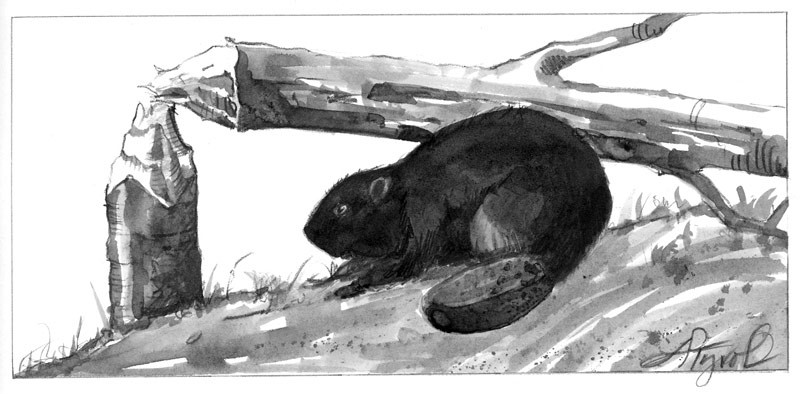
Creators of fabulously rich wildlife habitats or nuisance animals that cause flooding and property damage? It all depends on how you perceive the beaver, North America’s largest rodent. It’s hard to tolerate these animals after they destroy favorite trees or flood and damage a road. However, what many people fail to appreciate is the biological diversity and other benefits that beavers can bring to the landscape.
Like humans, beavers use engineering skills to re-shape their environment to secure places to live. By damming slow-flowing streams they create ponds that not only give them safe havens, but that also provide aquatic habitat for other animals and plants. In their immediate area they fell trees for dam-building materials and winter food, opening up clearings in which sun-loving wetland plants can flourish. This creates an entirely different ecosystem from the surrounding shady forest.
Beavers also excavate channels and eat large amounts of non-woody plants, such as cattails and certain grasses. This disturbance stimulates new, vigorous growth that provides food and shelter for many creatures. The species whose numbers would be diminished without beaver wetlands include moose, mink, muskrat, otter, ducks, herons, marsh hawks, bats, frogs, salamanders, turtles, fish and dragonflies.
(The beaver’s activities are not entirely helpful to all forms of wildlife, however. The water behind a beaver dam often spreads wide and moves slowly, so it warms easily on sunny days and holds less dissolved oxygen.)
For humans, there is another, often-overlooked benefit of beaver wetlands: The animals reduce chances of flash floods by slowing the rate at which water from rain or melting snow enters rivers.
Beavers build dams on streams that flow gently on shallow gradients, since fast water is too hard for them to contain. The locations where they can set up house thus are limited. Nonetheless, their dams are now appearing in places where they were not found in recent memory, though many of these areas in New Hampshire and Vermont were undoubtedly beaver habitat 400 years ago—before European explorers and settlers arrived in the region to capitalize on the fur trade and before later trappers operated without restriction.
By the mid-1800s beavers were virtually extinct in both states. Yet a half century ago they began making a comeback. And this was largely because of decisions by the two states to impose limits on trapping and to begin restocking programs. In New Hampshire in 1930, for example, six beavers were introduced to the wilds. Ten years later, 48 more were added. By 1955 the Granite State was considered repopulated with beaver. (Vermont was similarly restocked.)
Now that beavers have reoccupied their former range in the twin states, what do we do about their felling of yard trees and their activities that flood roadways? Beavers do have a few natural enemies, such as bears and coyotes, but natural predation is not always enough to control populations. Trappers remain by far the most effective predators, and, indeed, trapping is often the route taken by exasperated homeowners who unwittingly built in beaver territory. But trapping isn’t always the solution. That’s because beavers can respond to trapping by increased reproduction, and once a colony of beavers has been removed, newcomers can arrive. The animals can travel overland for up to 10 miles.
To protect their trees, homeowners do have the recourse of wrapping their trees’ lower trunks with hardware cloth.
The flooding problems can be addressed with specially designed devices that trick beavers into allowing more water through their dams. One such device, known as a beaver baffle, is basically a long, porous pipe that can be inserted through a dam. There are also special cages available to fit over roadside culverts to keep beavers from plugging them and flooding highways.
As winter draws near, humans and beavers alike begin hunkering down. We accumulate woodpiles, so do beavers. We use wood for fuel; they use it for food. To tide them through winter, they gather a cache of branches underwater and then reach them by swimming under the ice from the submerged entrance of their lodge. The lodge itself, a thick-walled dome of branches and mud, protects a dry platform where the beavers can huddle together and stay warm.
The beavers, with their home and dam-building expertise, are worthy of respect—even when their engineering projects present challenges to their human neighbors.

